For Faster Service Call Directly
FREE ESTIMATE
Request Your Pest Control Estimate
Are you familiar with the insects known as subterranean termites?
They live in the ground and inside the wood they consume, never exposing themselves to the light—if they can help it. When they get into man-made structures, these simple organisms can feed 24 hours a day, 7 days a week without stopping.
The kind of damage they do can be difficult to repair and sometimes leads to structural issues that can't be repaired.
If you live in Maryland, Virginia, or Washington D.C., you should take the time to learn about subterranean termites. These insects are active from early spring to late fall but, when conditions are right, they can feed on structures 365 days a year.
All they need to thrive is warmth and moisture, which are often abundant here.
That is why we strongly recommend professional termite control for property owners in our service area. If your property is not yet protected for the threat of subterranean termites, contact us for a consultation.
The team at American Pest has a proven track record for protecting properties from these destructive, wood-eating pests.
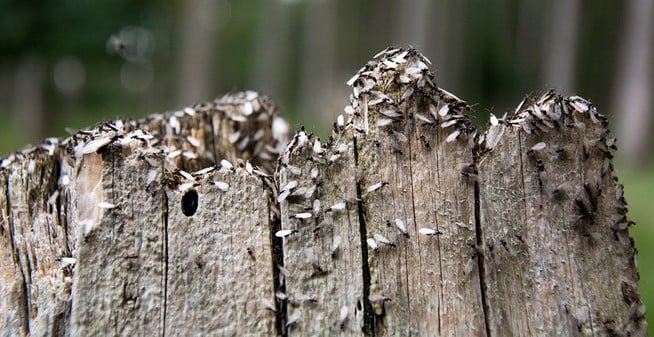
Request Your Pest Control Estimate
• Inspect your gutters to make sure you don't have any breaks or obstructions. This will help to prevent damp conditions near your home that can be attractive to termites.
• Consider trimming tree branches to allow sunlight to dry densely shaded areas around your home.
• Put some space between the plants in your landscaping to provide better airflow. This will help the wind dry your topsoil after watering.
• Remove wood debris from your yard. Subterranean termites are strongly attracted to decaying wood.
• If your home has a crawl space underneath, consider having it sealed and protected from moisture; spring can get damp and moisture can attract termites.
• Learn to identify termite swarms and how to tell the difference between termite swarmers and flying ants. Spring is the time of year when swarms occur.
• Learn what to do if you see a termite swarm, it could help you prevent serious damage to your property.
• Keep your lights off at night or replace exterior white lights with yellow, insect-resistant lighting to keep from attracting swarmers that emerge at night. Swarmers are drawn to light.
• If you have stumps or logs in your yard, see about having them removed.
• Make sure water is being diverted away from your home. If you have areas that are damp or stagnant puddles are forming, alter the conditions that are allowing this to occur.
•Never bury wood or waste lumber in your yard. Elevate any wood products that touch your soil. Decaying wood is a strong attractant for termites.
• Inspect your home and make sure there are no locations where the wood of your home touches the soil.
• Do an inspection of your exterior. Look for mud tubes on your foundation walls and other structures.Subterranean termites create these tubes to keep themselves from drying out.
Look in dark, hidden areas where worker termites are most likely to create these tubes. They may also make these tubes inside, so consider an interior inspection as well.
• Check some of the most common spots for termite activity around your home, and call American Pest immediately if you see evidence of damage in these areas.
• Rake leaves up and remove them from your property. Leaves create damp conditions that are inviting to termites. The last thing you want is to have a yard that is inviting to termites.
• The end of fall is a good time to trim bushes and move plants around. Good airflow in your landscaping will help the wind dry your topsoil after watering.
This can help to prevent the damp conditions that will attract termites to your home in the spring.
• Inspect your exterior walls and foundation for mud tubes. Worker termites create mud tubes from the soil around your home.
These tubes act as moist tunnels for workers to climb from the soil to the wood of your home. Look in dark locations for these tubes. Worker termites have an aversion to the light.
•Look: This is a good time of year to do an interior inspection of your home.
Search from your basement to your attic spaces for mud tubes on your walls. Subterranean termites create these tubes to protect themselves from being dried out.
• Listen: You would be hard pressed to hear termites inside your walls, even if you were to place your ear against a timber these insects are feeding on, but using a stethoscope can amplify the sound enough to detect the clicking sounds termites make when they hit their heads on tunnel walls to communicate with each other.
If you think you might have termites, you could play doctor on the wood in your basement or cellar and uncover evidence of an infestation.
Catching termites early can help to prevent serious damage to your property. Use these tips and remember that American Pest offers effective, year-round termite protection for homes and businesses in Maryland, D.C. and Northern Virginia. Don't wait till termites have made a meal of your property. Get protected now.
Termite colonies consist of a queen, a king, workers, soldiers, and alates. Each has a role to play in the development of the colony and the establishment of new colonies.
While we put the alates last on our list, they are the beginning of the termite life cycle. Alate, which means to have wings, are the only termites in the colony that can fly.
These male and female reproductives, usually called swarmers due to their swarming characteristic, are nurtured until they are ready to leave their colony to go out and establish new colonies. This usually happens in spring, when temperatures warm up.
After they mate, they lose their wings and become queens and kings.
The role of the queen is to create offspring. As she does this her abdomen grows larger and larger, making her look completely different from all the other termites in her colony. But her head and thorax remain the same. The role of the king is to help with fertilization. He stays by his mate and performs his duty throughout the life of the colony.
All of the offspring that come from the queen are workers.
These workers make up the vast majority of a termite colony and they are the only termites that have the ability to eat.
All other castes of termites rely on workers for their sustenance. Therefore, these are the termites that damage your property. Male and female alates do not.
As needed, a queen will communicate with workers through the use of pheromone scents and inspire them to develop into soldiers, which have the role of protecting the colony from predators and other threats.
She may also inspire workers to become alates as her colony reaches the appropriate size for replication and the cycle begins again.
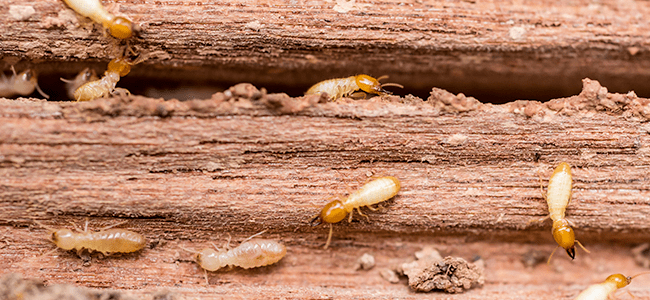
We are often asked, "Just how much damage can termites really do?" There seem to be a lot of opinions on the internet, and property owners have a hard time getting to the facts they're searching for.
Some websites say termites don't do much damage at all. Some say they can devour a home before the paint dries.
So how do you get to the real facts about termite damage?
While this may seem like a difference of opinion, it actually isn't. We have more than one species of termite in the United States and each presents a different level of threat to our properties.
Experts assert that there are around 45 different classifications of termite species in the U.S. and these can be broken down into three basic types:
Of these three types of termite, subterranean termites are head and shoulders above the rest in terms of how much damage they can do.
The annual damage done by subterranean termites in the United States is in the billions. The annual damage done by drywood and dampwood termites is in the hundreds of millions.
In our service area of Maryland, D.C. and Northern Virginia, we battle subterranean termites. While we can't tell you exactly how much damage subterranean termites do to homes and businesses in our area, we can tell you why they are so destructive, and our answer is likely to surprise you.
You would think that subterranean termites are destructive because they entirely consume the wood they feed on. But most subterranean termite species don't usually consume every inch of wood timbers. They prefer the soft grain of wood, not the hard parts.
So they aren't going to fully consume a few sole plates on your home and cause it to collapse in isolated areas that can be "easily" repaired.
They will feed through several timbers and make their way up through your home, silently weakening the entire structure.
Over time, this will cause your floors to sink, ceilings to dip, walls to bulge, door and windows to stick, and other anomalies. Their ability to do this without exposing themselves is what makes them so destructive.
When given enough time, subterranean termites can do irreparable damage to a home or business. For this reason, your termite control plan should take into account the detection of these sneaky and destructive insects.
You may know what termites look like but never see them to identify them as a threat to your home or business.
The vast majority of termites in a colony are worker termites.
They are the termites that feed on wood. These workers have a characteristic that makes them incredibly sneaky; they have an intense aversion to light. So you're not going to see worker termites crawling all over your walls as they consume your home.
These winged insects are the only termites you're likely to ever see, unless you're digging a hole on your property or doing some renovations.
But termite swarms don't last for more than 30 minutes. Those swarmers quickly mate and disappear into the ground or into the cracks of man-made structures.
Worse still, some property owners don't know how to tell the difference between swarming termites and flying ants or swarming termites and some other kind of insect. This can lead them to miss this important warning sign.
As we mentioned, termite workers have an aversion to light but the extent of this aversion will do more than keep them hidden from view; it will make the damage they cause to appear in hard-to-see locations.
You may immediately think of termites feeding on the inside of your wood beams from the bottom of your home to the top but we are referring to initial areas of damage that are close to the ground and are possible to be seen.
While you might be able to see damage done to the sole plates, which are the horizontal timbers of wood just above your foundation wall, termites will prefer to damage your sole plates underneath a deck, patio, porch, exterior stairs, and other structures that provide dark conditions.
If you go into a crawl space under your home, you may see no visible sign of damage as termite workers are going up the inside of your concrete piers to feed on the wood of your home.
They create these shelter tubes on surfaces to create a pathway from the ground to the wood of a home.
These shelter tubes, which are also called mud tube because they are created with soil and moisture, are usually going to be established in dark locations.
And since they are made from the soil around and underneath your home, they can be mistaken for naturally occurring phenomena.
So, as you can see, the warning signs of a termite infestation can be difficult to see. That is why it is important to have a termite control plan that offers a way to easily detect these sneaky pests, like the Sentricon® System with Always Active™. Learn about this powerful termite control product later in this document.
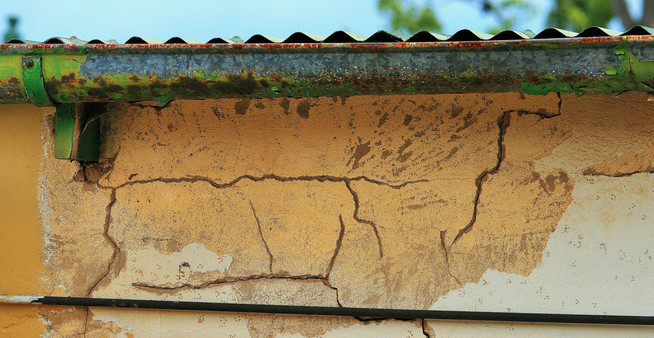
Preferred Care Complete is our trusted solution for around-the-clock termite control and prevention, packaged with superior pest control for 30+ home-infesting pests. The initial service includes a thorough interior/exterior home pest inspection and complete installation of the Sentricon® System for termites. Ongoing service is performed seasonally by one of our Certified Sentricon Specialists™. With Preferred Care Complete, your home is protected from termites and other pests 24/7/365, year after year. Termite Service Warranty and backed by our Pest Free Pledge.
For Faster Service Call Directly
301-232-5845There are many factors that can put a home at risk for termite infestations and all homeowners must be on guard when it comes to termites.
These tiny homewreckers can create widespread damage throughout a structure and cause damage that is unrepairable. Here are a few ways your home could attract the attention of subterranean termites:
Worker termites of a subterranean termite colony require high levels of moisture to survive. When winged queens search for a suitable location to establish a nest, damp soil will be high on their list.
If you have an external structure that has rotting wood or sun-damaged wood, your home will be at greater risk of an infestation. Subterranean termites prefer rotting wood to sound timbers.
When lumber is pressure treated, a chemical is pushed into the wood that helps to prevent the kind of decay that is attractive to subterranean termites.
This makes pressure-treated wood termite resistant.
That isn't to say that it is termite proof. Termites can still get into pressure-treated wood if it is old and has had contact with moist soil for an extended period of time. But wood that is not treated is far more attractive no matter what age the wood is.
Termites don't just eat wood. They eat many things that have cellulose. If you have a stack of cardboard near your foundation, termites will take notice. If you stack sticks underneath your deck, don't be surprised when termites are found inside your deck and inside your home.
Before termites get into your home, they can be lured into your yard by certain objects and conditions such as stored firewood or conditions of moisture.
These are two of the warning signs we give in our article3 signs you are inviting termites in your house.
Here are a few more intermediate food sources that can bring termites close to your home: old logs, fallen trees, brush, stumps, construction materials, wooden landscape borders, and wood that sits on the ground.
Not surprisingly, the risk of a termite infestation puts subterranean termites on another top 3 list of ours: 3 signs you need year-round pest control. If you have conditions that put your home at risk for a termite infestation, it is important to address them. Even more important is to invest in professional termite control.
If you do not have ongoing termite protection for your home, there are some steps you should consider taking to safeguard your home investment.
These prevention tips aren't easy but neither is trying to recover from the financial impacts of subterranean termite damage.
Early detection is the key to stopping serious damage. But in order to check your home for termites, you're going to have to get dirty. Subterranean termite signs are usually in dark or hidden locations and sometimes they can only be uncovered by literally uncovering them. You're going to have to go under your deck, porch, patio or stairs. You're going to have to go into crawl spaces. In these places, you may have to dig into the ground to find workers or you might have to use a mirror and a flashlight to search hard-to-see areas.
Subterranean termites are drawn to moisture. Keeping your landscaping and perimeter dry can have a big impact on termite activity. Clean your gutters. Repair leaky exterior spigots. Trim tree branches to allow sunlight into shaded places. Put space between the plants in your landscaping to allow for good airflow.
Removing wood and other potential termite foods from your yard is crucial to prevent a termite infestation. Keep in mind that anything that has cellulose can be a food source for these insects… not just wood.
The wood we use for our fires is highly attractive to subterranean termites. Always keep firewood and other wood material off the ground. This will prevent termite workers from having direct access.
An important warning sign of an infestation is the appearance of termite swarmers.
These tiny black insects with their long white wings may appear on your interior or exterior walls. When they do, it is vital that you be able to identify them and understand what you should do during a termite swarm.
Termite swarms should never be shrugged off. If you see swarmers on your home, they are not likely the evidence of an impending infestation but rather a current and mature infestation on your property.
For more tips on preventing pest infestation this summer, see Crucial Steps for Preventing Pest Infestation This Summer.
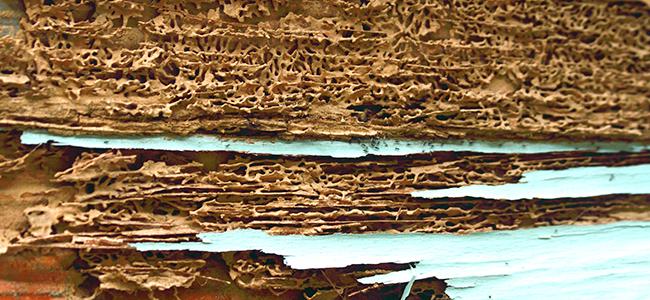
There are really only two options for effective termite control. One has been around for a very long time and is still a viable option. The other is only a couple of decades old but is quickly becoming the termite control option of choice.
The tried-and-trusted method for termite control is liquid termiticide treatments. It works by creating a chemical barrier around a structure. When termites pass through it, they come into contact with the active ingredient and share it with other termites by grooming.
While certainly effective, it falls short in a few key ways. It requires trenching and drilling. It puts tons of chemicals in the ground. And there is no way of knowing when the chemicals will wear out and become ineffective.
The newer solution is the use of termite bait stations and the most trusted product is the Sentricon® System with Always Active™.
Sentricon® is the only termite control product to win the Presidential Green Chemistry Award and no other termite bait product has had as many scientific studies and papers written about it.
If you can't tell by our enthusiasm, this is the product we use. It doesn't require drilling or trenching. It doesn't require the use of chemicals. And the units make termite detection a breeze.
If termites try to eat your home, you're going to know about it. Your technician will be able to show you. There is no way to put a price on this.
Many property owners give up on their essential termite protection because liquid barriers don't provide any evidence that termites are a serious threat. With Sentricon®, you'll have no doubt that this was a vital investment for your equity. If you want help winning the battle against termites check out Termite Control Liquid vs Bait.
There are few pests that can have as much of an impact on a family or a business as subterranean termites.
The damage caused by subterranean termites can be throughout an entire structure and lead to cascading issues.
But the worst part about subterranean termites is that you aren't likely to know when your DIY termite treatments have failed to protect your property. Here are a few reasons why:
• These insects travel as far as the length of a football field under the ground to find food sources. You won't see worker termites crawling in your yard and you won't see them crawling on your home.
• When they attack the wood of your home, they come up from the soil and feed on the inside of your wood. If you're fortunate, you may see mud tubes on foundation walls but worker termites usually create these mud tubes in dark, hidden areas—if they create them at all.
• While the appearance of termite swarmers can be a sign of termite infestation, swarms don't last for more than 30 minutes. A swarm could come and go in the time it takes you to grab some stuff at Walmart.
When these swarmers are released into the air, they could fly right off your property in a matter of a minute or two.
Another important reason to contact a professional is the fact that licensed and certified termite control professionals use field-tested products and methods that are known to prevent termite damage.
Some even provide a termite-damage warranty. This means you'll never have unexpected repair costs stacking up. You'll know exactly how much subterranean termites are going to cost you. For more details on the average cost of termite treatments or how much termite control may cost, see our other articles on this subject.
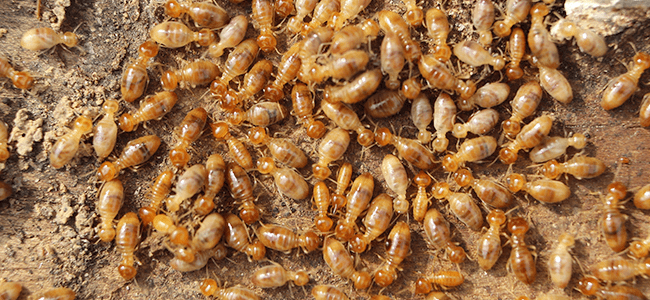
If you live in Maryland, D.C. or Northern Virginia, American Pest is the right choice for termite control.
We have a track record of successfully using the eco-friendly, award-winning, Sentricon® System to protect homes, businesses, and important historical structures in our service area.
We are a certified Sentricon® Installer and an industry-leading pest control provider. But you don't have to take our word for it.
Our reviews speak for themselves. Our team has earned the Angie's List Super Service Award several years in a row. This takes dedication to service and a commitment to ongoing pest control education and certifications.
We provide professional termite inspections for home buyers and sellers and ongoing termite control for homeowners and business owners.
Find out if you're in our extensive service area and let our QualityPro and GreenPro Certified team help you protect your investment from the destructive impact of subterranean termites.
Find out what our customers are saying. Click links to read or leave a review.
L. Jones - Laurel, MD
“ They were respectful workers that were excellent, timely, reasonable, and thorough. It was worth every penny!
![]()


Angie's List Customer
“ The service technician was punctual, courteous, and very thorough. He took the time to explain each step in the process to treat our home. And, the services have resulted in a reduction/near elimination of pests in and around our home.”


V. Maier - Silver Spring, MD
“ American Pest service technicians are always willing to take their time and listen to concerns, answer questions and crawl around checking out areas that may show signs of intruding insects or rodents.”
If you have questions about our services, plans, or pricing, we are here for you. Call or fill out the form to communicate by email.